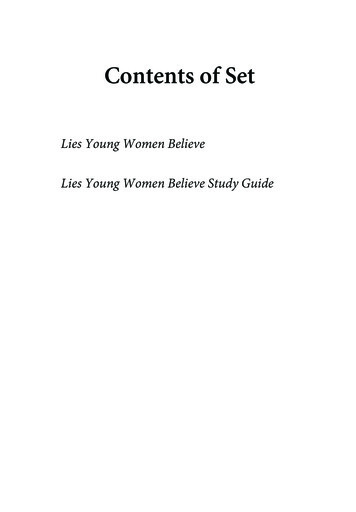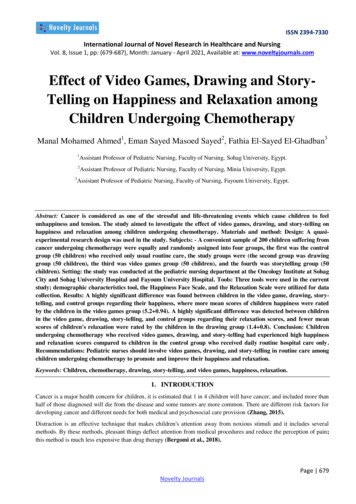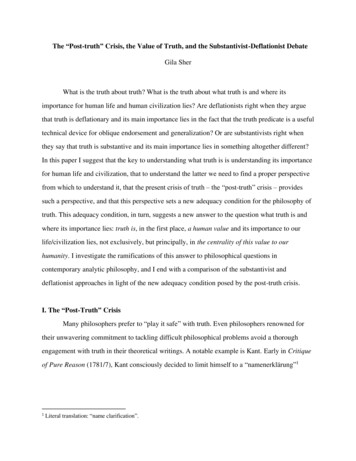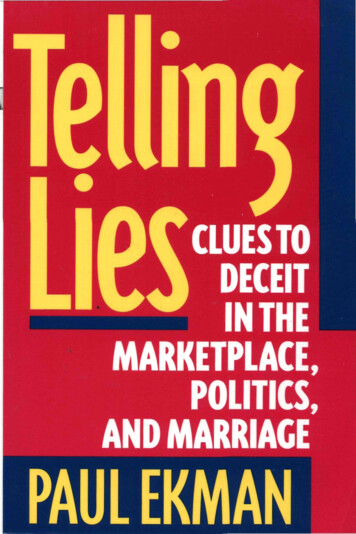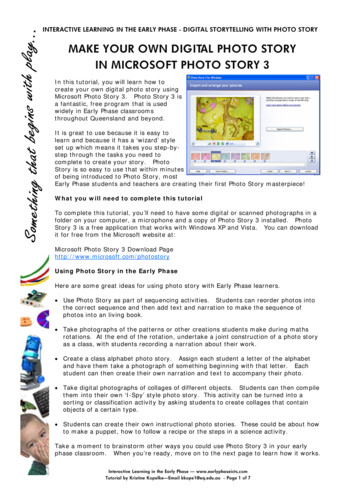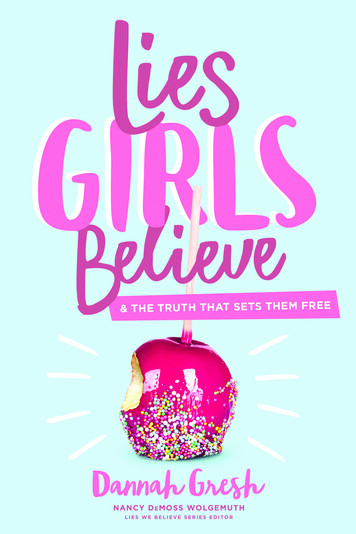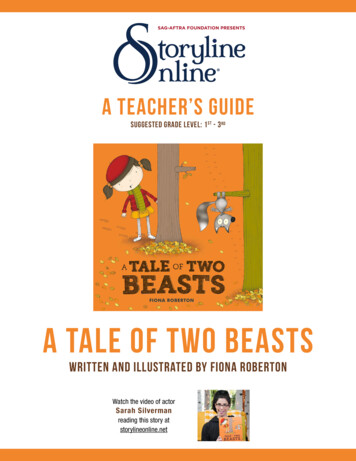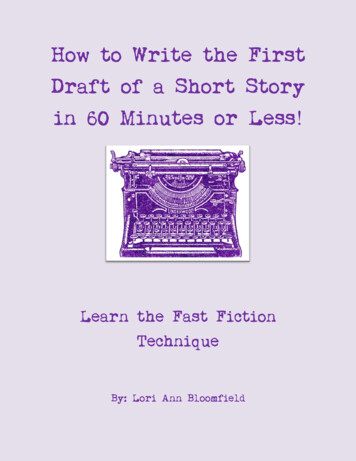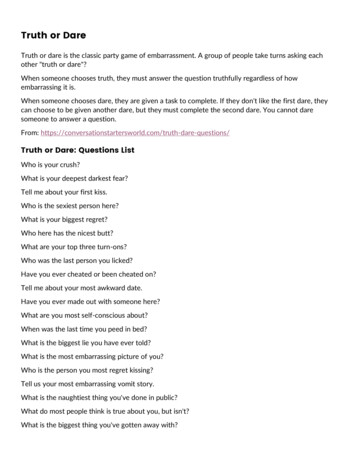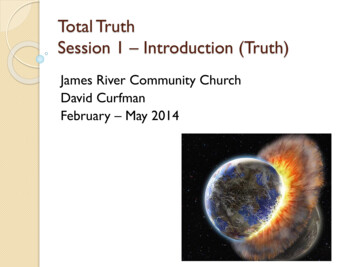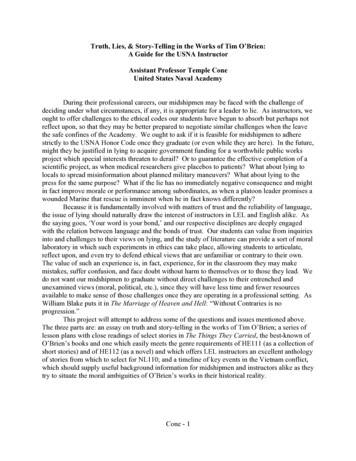
Transcription
Truth, Lies, & Story-Telling in the Works of Tim O’Brien:A Guide for the USNA InstructorAssistant Professor Temple ConeUnited States Naval AcademyDuring their professional careers, our midshipmen may be faced with the challenge ofdeciding under what circumstances, if any, it is appropriate for a leader to lie. As instructors, weought to offer challenges to the ethical codes our students have begun to absorb but perhaps notreflect upon, so that they may be better prepared to negotiate similar challenges when the leavethe safe confines of the Academy. We ought to ask if it is feasible for midshipmen to adherestrictly to the USNA Honor Code once they graduate (or even while they are here). In the future,might they be justified in lying to acquire government funding for a worthwhile public worksproject which special interests threaten to derail? Or to guarantee the effective completion of ascientific project, as when medical researchers give placebos to patients? What about lying tolocals to spread misinformation about planned military maneuvers? What about lying to thepress for the same purpose? What if the lie has no immediately negative consequence and mightin fact improve morale or performance among subordinates, as when a platoon leader promises awounded Marine that rescue is imminent when he in fact knows differently?Because it is fundamentally involved with matters of trust and the reliability of language,the issue of lying should naturally draw the interest of instructors in LEL and English alike. Asthe saying goes, ‘Your word is your bond,’ and our respective disciplines are deeply engagedwith the relation between language and the bonds of trust. Our students can value from inquiriesinto and challenges to their views on lying, and the study of literature can provide a sort of morallaboratory in which such experiments in ethics can take place, allowing students to articulate,reflect upon, and even try to defend ethical views that are unfamiliar or contrary to their own.The value of such an experience is, in fact, experience, for in the classroom they may makemistakes, suffer confusion, and face doubt without harm to themselves or to those they lead. Wedo not want our midshipmen to graduate without direct challenges to their entrenched andunexamined views (moral, political, etc.), since they will have less time and fewer resourcesavailable to make sense of those challenges once they are operating in a professional setting. AsWilliam Blake puts it in The Marriage of Heaven and Hell: “Without Contraries is noprogression.”This project will attempt to address some of the questions and issues mentioned above.The three parts are: an essay on truth and story-telling in the works of Tim O’Brien; a series oflesson plans with close readings of select stories in The Things They Carried, the best-known ofO’Brien’s books and one which easily meets the genre requirements of HE111 (as a collection ofshort stories) and of HE112 (as a novel) and which offers LEL instructors an excellent anthologyof stories from which to select for NL110; and a timeline of key events in the Vietnam conflict,which should supply useful background information for midshipmen and instructors alike as theytry to situate the moral ambiguities of O’Brien’s works in their historical reality.Cone - 1
Truth, Lies, & Story-TellingIn the Works of Tim O’BrienThe novels and stories of Tim O’Brien are, at their core, epistemological studies; that is,they attempt to make sense of how we know what we know. For O’Brien, any notion of ‘truth’is fundamentally individual and ambiguous; as he writes in In the Lake of the Woods, “Howoften do we lie awake speculating—seeking some hidden truth . We find truth inside, or not atall” (295). Yet this condition does not preclude truthfulness for O’Brien, for one maynevertheless accurately represent the whirl of individual and ambiguous truths that composes ourreality without having to grasp at a single, exclusive, ‘true’ version of that reality. Such surety inthe midst of uncertainty is what the poet John Keats calls “Negative Capability, that is when manis capable of being in uncertainties, Mysteries, doubts, without any irritable reaching after fact &reason” (43). For Tim O’Brien, such a relation to truth is best achieved by telling stories, since“Stories are for eternity, when memory is erased, when there is nothing to remember except thestory” (TTTC 38).Concerned with issues of truth, story-telling, and the relation between the two, O’Brienfocuses much of his writing on the difficulty of telling the truth about war, from the experienceof combat to the challenge of returning home after war. (Although the Vietnam War colorsmany of his writings, O’Brien rejects the label of war novelist; for him, war occasions and/orexemplifies human life under pressure, a condition that can be experienced in any number ofother situations.) O’Brien’s interest in truth-telling and war is not unique; one of his importantpredecessors is Ernest Hemingway, whose collection of short stories and vignettes In Our Timeprovides an important model for the organization of O’Brien’s book The Things They Carried.In his short story “Soldier’s Home,” Hemingway writes that the story’s protagonist, HaroldKrebs, disaffected after his return from WWI, spends his time reading about the engagements inwhich he served, noting that “Now he was really learning about the war. He had been a goodsoldier. He made a difference” (72). Krebs’s struggle is a crucial one for the combat veteran’sexperience, since factual accuracy can supply a sense of pattern and order to counterbalance thechaos, disorder, and potential meaninglessness of war.But the effort to arrive at the absolute truth about an event is beset with problems, sincethe excess of factors involved in war prevents any one participant from grasping and representingthe whole. Writer and journalist Michael Herr suggests that the very nature of the war inVietnam intensified the difficulty of explaining just what happened there, and he illustrates thisview in a brief anecdote from his book of Vietnam reporting, Dispatches. Herr writes “‘Patrolwent up the mountain. One man came back. He died before he could tell us what happened’”(6). While O’Brien also represents the experience of Vietnam as one in which it is particularlydifficult to “tell what happened,” he finds that an inherently epistemological problem andmore general than the Vietnam experience itself. In Going After Cacciato, Captain Rhallon saysthat “[The soldier] registers only those few items that he is predisposed to register and not asingle thing more . (A)fter a battle each soldier will have different stories to tell, vastlydifferent stories” (196). Nevertheless, that effort to locate and express the truth about anexperience, particularly the experience of trauma, is crucial; to do otherwise is to abandon one’sself to the madness of chaos and meaninglessness.At the opposite end of the spectrum from absolute truth is the absolute absence of truth,manifest in the unreality of daydreaming, which O’Brien associates with escapism, and inCone - 2
cultural amnesia and blindness, which characterizes the American response to Vietnam bothduring the war and afterward. It is no coincidence that many of O’Brien’s most traumatizedcharacters—Paul Berlin, Norman Bowker, John Wade—often lose themselves in a dream worldthat protects them from the brutalities of the real world. Nor is it surprising that O’Brien’s mostdepraved yet perhaps most sympathetic character, John Wade (In the Lake of the Woods), is notonly a skilled stage magician, but also a skillful amnesiac. Wade edits his Army service recordsto conceal his presence at the My Lai massacre, then conceals these facts from his wife andultimately from himself. Only when implicating photos emerge during his failed senatorialcampaign does Wade begin to confront the truth, only to enact an even greater trick offorgetfulness as he conceals from himself his own likely culpability in the disappearance (andlikely death) of his wife before disappearing himself in the woods of northern Minnesota. ForO’Brien, daydreaming and cultural blindness obscure the relative complexities of truth just asfully as the insistence on absolute truth; to be swept up in illusions or denial during the traumaticexperiences of war is not unexpected, but unchecked it can be dangerous, for an utter divorcefrom reality also signals a divorce from morality.Fiction proves the golden mean between absolute truth and absolute dream. It isimpossible to ascertain the absolute truth of an experience, but it is nevertheless critical that onetry to ascertain the multiple truths, to be “in uncertainties, Mysteries, doubts, without anyirritable reaching after fact & reason,” and this challenge marks the human condition. Fiction isneither counter to nor identical with the truth, though given the exigencies of war, fiction oftenprovides the best approximation of reality; as O’Brien writes in “How to Tell a True War Story,”“In war you lose your sense of the definite, hence your sense of truth itself, and therefore it’s safeto say that in a true war story nothing is ever absolutely true” (TTTC, 82). O’Brien claims that“My role is not to solve mysteries, but to expand them To ultimately make readers think oftheir lives in terms of ambiguity. It’s the human condition and we’re uncertain about almosteverything” (Hicks, 89-90). The storyteller takes the facts of experience and embellishes or evenalters them in order to get at a closer experience of truth; O’Brien finds in fiction the possibilityof expressing “that surreal seemingness, which makes the story seem untrue, but which in factrepresents the hard and exact truth as it seemed” (TTTC, 71). Thus, the capacity to tell a story, tomake a factual account that leaves out the subjective experience into a fictional but seeminglymore truthful account, is essential to understanding the experience of war for all involved and tobeginning the long process of recovering from its damages and of correcting its failures.Why is O’Brien’s work so unrelentingly preoccupied with issues of truth and fiction?Such obsessions may be directly related to the experience of the Vietnam War itself, in whichunclear motives, deceptive operations, an alien culture, and an anonymous citizenry created anatmosphere of ambiguity in which ascertaining the facts of war proves an incredible challenge.Writing about the summer he was drafted, O’Brien remarks, “The only certainty that summerwas moral confusion. It was my view then, and still is, that you don’t make war withoutknowing why. Knowledge, of course, is always imperfect, but it seemed to me that when anation goes to war it must have reasonable confidence in the justice and imperative of its cause.You can’t fix mistakes. Once people are dead, you can’t make them undead” (TTTC, 39-40).For O’Brien, daydreaming, amnesia, and an insistence on absolute truth represent a failure tonegotiate the ambiguity of truth, and such a failure makes us vulnerable to manipulations of thetruth, the consequences of which can be devastating. As he warns us in “How to Tell a True WarStory,” “You can tell a true war story if it embarrasses you. If you don’t care for obscenity, youCone - 3
don’t care for the truth; if you don’t care for the truth, watch how you vote. Send guys to war,they come home talking dirty” (TTTC, 69).To better understand the ties between truth, lying, and the Vietnam conflict in O’Brien’sfiction, a few important instances of U.S. political deception during the Vietnam era bearrepeating: Gulf of Tonkin: Though there had been a relatively significant U.S. presence in Vietnamsince 1950, it escalated following the alleged attacks on U.S. destroyers in the Gulf ofTonkin by Vietnamese torpedo boats on August 2 and 4, 1964. These attacks promptedPresident Lyndon Johnson to demand full Congressional support for a response to theattacks, leading to the Gulf of Tonkin Resolution, which did not declare war on Vietnambut nevertheless pleased President Johnson, who said of it (according to Johnsonbiographer Robert Dallek) “It’s just like Grandma’s nightshirt. It covers everything.” The 1964 Campaign: Running against Cold Warrior Barry Goldwater, Johnson called hisopponent a war-monger and promised not to go to war. Johnson carried all but fivestates, but he and his circle did not believe they could withdraw from Vietnam, fearingthe political damage. The Tet Offensive: From January to March, 1968, the National Liberation Front (NLF,aka “Viet Cong”) launched an offensive coinciding with the Tet holiday, fighting in citieswhich were thought secure since 1965. Though the offensive proved a military defeat forthe NLF, it did great damage to the credibility of the U.S. military and civilian leadership,which had long assured the public media of the security of these areas. As a measure ofpublic reaction against Johnson, which had been building for some time but which mayhave reached a boiling point in the wake of Tet, we might look at the March 1968Democratic primary in New Hampshire. Johnson won, but Eugene McCarthy,campaigning on his opposition to Vietnam, received a substantial percentage of the vote(42% to Johnson’s 49%), shocking the press. Later that month, Johnson announced thathe would not seek re-election. Incursion into Cambodia: Under President Richard Nixon, the U.S. stepped up its air warin Northern Vietnam, secretly extending its campaign into NVA (North VietnameseArmy) sanctuaries in Cambodia, which was a neutral state.These instances of uncertainty and political deception both exacerbated and symbolized theconfusing challenges that the U.S. military encountered in Vietnam, and their very realconsequences touched O’Brien directly and continue to fuel his epistemological concern withtrying to tell the truth about the Vietnam experience.But doesn’t the effort to ‘tell the truth’ about what apparently cannot be truthfully toldamount to lying? Doesn’t the manipulation of biography and factual events in order to craft acompelling story, as O’Brien does in “On the Rainy River,” amount to lying? And shouldn’t we,as truth-seekers, reject lying? Perhaps not, according to philosopher Sissela Bok. In Lying:Moral Choice in Public and Private Life, Bok criticizes the absolute rejection of lying typifiedby Kant’s categorical imperative, which holds that one should act only if one couldsimultaneously will that one’s action would become a universal law. For Bok, there are indeedCone - 4
circumstances in which it is not only possible to lie, but morally appropriate to do so (as whenone lies to a murderer about the location of a potential victim). But Bok also rejects a facileutilitarianism that holds that truth and lies are to be distinguished only by the relative good orharm they bring; rather, lies are exceptional. Yet the liar often overestimates the instances inwhich such exceptional lies are appropriate. Many lies overlook alternative solutions to thecircumstances they attempt to resolve, and as a result, they contribute to detrimental practicesthat steadily erode relations to truth.Two key criteria for Bok in terms of determining the appropriateness of lies are whetheror not such lies will contribute to a future practice of lying and whether or not they stand up tothe test of publicity. In the former instance, she asks if the lie will expedite or otherwise helprationalize the telling of other lies, and she rejects the lie if it may produce other foreseeabledeceptions. In the earlier circumstance of lying to a murderer about the whereabouts of hisvictim, Bok suggests that such an exceptional circumstance is unlikely to become the standardfor other questions about whereabouts (say questions asked by a parent), and if the lies are told incircumstances where there is an ongoing threat to survival (say when the murderer is a Nazi andthe victims in question are Jews one is hiding as part of one’s efforts at resistance), then thethreatening environment suspends any judgment about the harmful effects of any longstandingpractice of deception.In the latter instance, Bok argues that lies must bear the test of publicity; that is, of publicscrutiny and judgment. Here, Bok is pushing for us to judge the lie in anticipation of ourselvesbeing the dupes of the lie. Certainly there are circumstances where deception is necessary andneeds no outside verification, but more often than not, Bok argues, a public consideration of thevalue and validity of such lying will not limit its future effectiveness (as when we have a publicdiscussion of the right of our government to send spies abroad). Moreover, public considerationwill guarantee the responsibility for judging the validity of the lie rests not with the liar, who willoften exaggerate the need for deception, but with potential victims, who will be more scrupulousand discerning on the basis of self-interest.Where does fiction fit in the continuum between truth and deception? There is alongstanding conflict in Western culture over this issue, and two of the most familiar positionscome to us from Plato and from the Romantic poet and critic Samuel Taylor Coleridge. In theRepublic, Plato argues that literature and art are at three removes from nature, and he justifies hisbanishment of “the poetic tribe” from his ideal state by claiming that “mimetic art is far removedfrom truth” (823) and that “if [the artist] had genuine knowledge of the things he imitates hewould far rather devote himself to real things than to the imitation of them” (824). Yet Coleridgeargues in Bibliographia Literaria that literature invites and requires a “willing suspension ofdisbelief” (264) or the audience’s consent to be deceived in order to function, such consentoverriding any accusations of deception. Bok’s few comments about fiction appear in a chapteron paternalistic deception (the use of deception to guide and coerce others, often children, inorder to serve their best interests). She cautions against labeling fiction deception, since doing somakes it easier to regard lying as simply the act of telling stories, whereas genuine storytellingalways supposes a willing suspension of disbelief; that is, “fiction does not intend to mislead”(207). Yet she notes in a footnote that there are borderline areas where fiction and willfuldeception cooperate, and one instance of this mingling is of particular interest in discussingO’Brien. Bok writes that fiction may be considered deceptive “if the author mingles fiction andpurportedly factual statements without signaling where the ‘suspension of disbelief’ isappropriate” (207).Cone - 5
This latter instance of deception seems especially pertinent to The Things They Carried,given the many counterfactual events O’Brien describes (e.g. O’Brien’s attempt to flee toCanada in “On the Rainy River” when he in fact spent the summer playing golf before acceptinghis orders; the presence of his 9-year old daughter Kathleen when O’Brien in fact has nodaughter; etc.). Yet if Bok’s criterion is a clear signal for the willing suspension of disbelief,then there could be no clearer signal than the subtitle of The Things They Carried is “A Work ofFiction.” Our failure to remember this claim (or disclaimer) is one of the great concerns inO’Brien’s writing.On the one hand, overlooking the subtitle exemplifies a more general American failure topay attention to words, to expressions of meaning through language, as when we use the words“patriotism,” “enemy,” “liberty,” and even “fiction” without reflecting upon what they mean.Inattentiveness and imprecision with regards to language can expose us to the manipulation oflanguage, and this exposure can have real consequences. O’Brien speaks to this point in “On theRainy River,” where he rails against the locals of his hometown, “a conservative little spot on theprairie, a place where tradition counted,” condemning “their blind, thoughtless, automaticacquiescence to it all, their simpleminded patriotism, their prideful ignorance, their love-it-orleave-it platitudes, how they were sending me off to fight a war they didn’t understand and didn’twant to understand” (45). For O’Brien, those who embrace clichés and maudlin sentiments arethe same who cannot accept the obscenities of war, yet are willing to have others sent to wagewar, and it is this inconsistency that his mingling of the fictional and the factual so poignantlyreveals.On the other hand, that we might confuse fiction with reality speaks to the great powerthat literature has over our emotional lives, a power that might heighten our moral sense andguide us away from cliché toward a more attentive search for truth and meaning. At the momentin “On the Rainy River” when Tim O’Brien must choose between swimming into Canada to savehis life or going to Vietnam to fight in war he does not support, he writes that “Inside me, in mychest, I felt a terrible squeezing pressure. Even now, as I write this, I can still feel that tightness.And I want you to feel it” (56), a moment of empathy that allows O’Brien to set up the moralchallenge that so many great works of literature offer: “What would you do? Would you jump?Would you feel pity for yourself? Would you think about your family and your childhood andyour dreams and all you’re leaving behind? Would it hurt? Would it feel like dying? Wouldyou cry, as I did?” (56, emphasis added).The difficulty of ascertaining truth gains power in the issue of whether or not O’Brienkilled anyone during the war. In “The Man I Killed,” the factual details of the dead VC’s bodyare intermingled with imaginings about the man’s life, so much so that as soon as we begin tobelieve the fact (or fiction) of the man’s existence and death, the opposite conclusionimmediately arises, a wavering between the literal and figurative that is mirrored in the syntax ofthe man’s thoughts about his future in the war: “He knew he would fall dead and wake up in thestories of his village and people” (TTTC, 130). The dead soldier does begin to seem a literaryinvention, since he serves as a doppelganger or double for O’Brien, his death a metaphor forO’Brien’s own loss of innocence in the war. But this conclusion is complicated by the matter ofTim O’Brien’s narrative of his own return to Vietnam in “Field Trip,” a trip that seems quiteplausible and realistic, except that Tim O’Brien is accompanied by his nine-year old daughterKathleen, who is in fact an invention (O’Brien had no children at the time he wrote TTTC).It is in the vignette “Good Form” that O’Brien acknowledges and justifies hismanipulation of truth and reality in his stories. Writing that “I want you to know why story-truthCone - 6
is truer sometimes than happening-truth” (179), he asserts that “What stories can do, I guess, ismake things present” (180). While the aside “I guess” suggests that even this simple claim mustbe qualified against the complex ambiguities of reality, the claim is nevertheless key tounderstanding the drive of O’Brien’s works and their epistemological import. For O’Brien,stories retrieve the past and allow us to experience it again, reviewing, reliving, and reflectingupon the events and the perceptions of each person involved. Each alteration of the known factsis licensed by the power of the story to make us “feel what I felt” (179), the emphasis onempathy reminding us of the importance of stories (told and received) in recovering fromtrauma. O’Brien’s works teach us to accept the limitations of reason and to reside in thatambiguous space where truth and fiction cannot be teased apart. Yet they also offer the chanceto recover what has been lost—friends, innocence, memory—and experience them once more,fantasizing about how we might have acted differently in the past and then accepting how we didact, the better to act as we would wish—bravely, always bravely—in the future. “But this too istrue,” O’Brien writes in “The Lives of the Dead,” “stories can save us” (225).Cone - 7
Lesson Plan(s) on Truth, Lies, & StorytellingIn Tim O’Brien’s The Things They CarriedLeading quotations from “The Things They Carried” and bullet points marked in bold go onboard. This lesson plan focuses on literary devices, conflicts, and themes from The Things TheyCarried, though the discussions can be extended to the rest of O’Brien’s writings. The fivenumbered sections can be used for a single class (though it might be a bit packed) or broken intofive different classes (each corresponding to a Roman numeral) or any combination thereof.I. “They carried catch as catch can” Storytelling as a fight for life: For O’Brien, the trauma of war disorders military andcivilian lives alike, and storytelling is an important means of surviving that disorder,since stories impose a narrative pattern and offer both author and audience catharsis (thepurging of unwanted emotions through the experience of pity and awe). While we shouldbe cautious about reading too much of an author’s biography into his or her writings,O’Brien foregrounds his own experience of the Vietnam War in order to authenticate hisclaims. Yet one of the dangers O’Brien warns against is a naïve acceptance of theseeming truth of first-hand accounts; one of his most powerful stories about the painfuleffects of the war, “On the Rainy River,” recounts Tim O’Brien’s failed effort to flee toCanada upon being drafted, ending with the painful admission that “I was a coward. Iwent to the war.” Yet as O’Brien inevitably asserts during his public readings of thestory, the narrative is pure fiction. While he did have political and philosophicalreservations against the war, he accepted his draft orders and did not try to flee the UnitedStates. The truth of the story, O’Brien asserts, isn’t based in its ‘facts,’ but in itsemotional weight and credibility; “On the Rainy River,” like many other stories in thecollection, is “a tale created and told to define the experience of wanting to run but beingunable to gather the courage to do so” (Smith, Companion, 5). The need to articulatethese feelings clashes with the ‘facts’ of what happened, at which point the superficialfacts no longer serve and the author must employ the imagination to get at the truth.Reflecting on his own career as a storyteller, O’Brien remarks that “when I take a highleap into the dark and come down thirty years later, I realize it is as Tim trying to saveTimmy’s life with a story” (246). Just as one fights for one’s life by any means available,so one tells a story by any means available; among the conflicts O’Brien faces are:1. Ambivalence about the war, before and after2. Memories of his own experiences during the war3. The evil of American soldiers at My Lai (Than Khe) in the Quang Ngai provinceand the need not to forget it TTTC as collage of various genres: O’Brien subtitles TTTC “A work of fiction,” and theterm “fiction” has important implications for the genre of the book. Is this a novel?TTTC deals with a fairly constant cast of characters, features recurrent settings, has alinear narrative thread in addition to its numerous digressions, and explores a core set ofCone - 8
themes throughout. Yet many of its chapters were originally published as separate shortstories in different journals, and several are frequently included in short story anthologies,so is it a collection of stories? There are several full-length short stories, each with thatsense of completeness we attribute to the short story form, yet there are a number ofpieces in TTTC that function mostly as vignettes or inter-chapters that implicitlycomment on the stories they follow and precede. Moreover, since O’Brien uses so manydetails from his own life and service in Vietnam, we might be inclined to ask if this is amemoir. Yet the subtitle seems to suggest otherwise, and O’Brien might be alerting usnot to be taken in by promises of factuality, when “happening-truth” and “story-truth”exist in such an ambiguous relation to each other.1. TTTC is a novel because it is a fictional prose narrative dealing with the complexexperiences of a more or less constant set of fictional characters.2. TTTC is also a short story collection, because its individual chapters have titles oftheir own and were in many instances originally published as independent shortstories, meaning that they complete themselves emotionally and dramatically in away that novel chapters, woven as they are into a larger and preconceived whole,cannot.3. TTTC is a memoir, because many of its chapters/ stories concern the experiencesof a narrator / protagonist named “Tim O’Brien,” whose background andcharacter are in many instances identical with the author’s but on certain pointsare clearly fictionalized.4. TTTC is a collection of tall-tales, like Mitchell Sanders’s story of the phantomorchestra, though some prove to be not only plausible but verifiable (as in the caseof Mary Anne in “Sweetheart of the Song Tra Bong”).5. TTTC contains many passages that might be called essays in aesthetics, in whichthe narrator Tim O’Brien and other characters discuss different approaches to &reasons for telling stories. Such passages are typical of metafiction, or fiction thatis self-conscious of its own fictional nature and that foregrounds its narrativetechniques. Storytelling techniques in TTTC: The title story of the collection, “The Things TheyCarried” is perhaps O’Brien’s best-known and most anthologized story. O’Brien’sefforts at creating the reality of the soldiers’ experience in Vietnam are aided by his useof several literary devices. Note how O’Brien uses highly literary and artificialtechniques to evoke a sense of the war that many consider to be ‘realistic’ (not artificialor contrived). Is O’Brien already setting us up for a conflict between ‘truthfulness’ and‘factual accuracy’?1. Catalogues: O’Brien uses long catalogues to detail the many different things thatAmerican soldiers in V
Truth, Lies, & Story-Telling In the Works of Tim O'Brien The novels and stories of Tim O'Brien are, at their core, epistemological studies; that is, . provides an important model for the organization of O'Brien's book The Things They Carried. In his short story "Soldier's Home," Hemingway writes that the story's protagonist .
